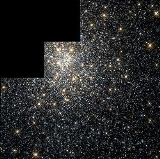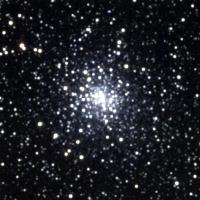
Messier 28
Encyclopedia
Messier 28 is a globular cluster
in the constellation
Sagittarius
. It was discovered by Charles Messier
in 1764. In the sky it is very close to the 3rd magnitude
star Kaus Borealis.
M28 is at a distance of about 18,000 to 19,000 light-year
s away from Earth
. 18 RR Lyrae
type variable star
s have been observed in this cluster. In 1986, M28 became the first globular cluster where a millisecond pulsar
was discovered (by the Lovell Telescope
at Jodrell Bank Observatory).

Globular cluster
A globular cluster is a spherical collection of stars that orbits a galactic core as a satellite. Globular clusters are very tightly bound by gravity, which gives them their spherical shapes and relatively high stellar densities toward their centers. The name of this category of star cluster is...
in the constellation
Constellation
In modern astronomy, a constellation is an internationally defined area of the celestial sphere. These areas are grouped around asterisms, patterns formed by prominent stars within apparent proximity to one another on Earth's night sky....
Sagittarius
Sagittarius (constellation)
Sagittarius is a constellation of the zodiac, the one containing the galactic center. Its name is Latin for the archer, and its symbol is , a stylized arrow. Sagittarius is commonly represented as a centaur drawing a bow...
. It was discovered by Charles Messier
Charles Messier
Charles Messier was a French astronomer most notable for publishing an astronomical catalogue consisting of deep sky objects such as nebulae and star clusters that came to be known as the 110 "Messier objects"...
in 1764. In the sky it is very close to the 3rd magnitude
Apparent magnitude
The apparent magnitude of a celestial body is a measure of its brightness as seen by an observer on Earth, adjusted to the value it would have in the absence of the atmosphere...
star Kaus Borealis.
M28 is at a distance of about 18,000 to 19,000 light-year
Light-year
A light-year, also light year or lightyear is a unit of length, equal to just under 10 trillion kilometres...
s away from Earth
Earth
Earth is the third planet from the Sun, and the densest and fifth-largest of the eight planets in the Solar System. It is also the largest of the Solar System's four terrestrial planets...
. 18 RR Lyrae
RR Lyrae variable
RR Lyrae variables are periodic variable stars, commonly found in globular clusters, and often used as standard candles to measure galactic distances.This type of variable is named after the prototype, the variable star RR Lyrae in the constellation Lyra....
type variable star
Variable star
A star is classified as variable if its apparent magnitude as seen from Earth changes over time, whether the changes are due to variations in the star's actual luminosity, or to variations in the amount of the star's light that is blocked from reaching Earth...
s have been observed in this cluster. In 1986, M28 became the first globular cluster where a millisecond pulsar
Millisecond pulsar
A millisecond pulsar is a pulsar with a rotational period in the range of about 1-10 milliseconds. Millisecond pulsars have been detected in the radio, X-ray, and gamma ray portions of the electromagnetic spectrum. The origin of millisecond pulsars is still unknown...
was discovered (by the Lovell Telescope
Lovell Telescope
The Lovell Telescope is a radio telescope at Jodrell Bank Observatory, near Goostrey, Cheshire in the north-west of England. When it was constructed in 1955, the telescope was the largest steerable dish radio telescope in the world at 76.2 m in diameter;it is now the third largest, after the...
at Jodrell Bank Observatory).


